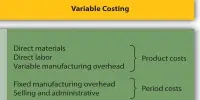Valuation of Finished Goods Inventory under Variable Costing and Absorption Costing
Absorption costing is a management accounting method for accumulating all production costs in the value of produced inventory. It is also known as ‘full costing,’ and it is required for a company’s external reporting in order to be GAAP or IFRS compliant.
Products can absorb a wide range of Fixed and Variable costs. These are not recorded as expenses in the current period in which they are incurred. Instead, these costs are retained in inventory until the products are sold, at which point they are charged to COGS (cost of goods sold). Absorption costing is a method of valuing inventory that takes into account the cost of materials and labor, as well as variable and fixed manufacturing overheads.
Variable costing only considers costs that are directly affected by changes in production volume, whereas absorption costing considers all direct and indirect production costs. Internally, variable costing is used for budgeting and forecasting, whereas absorption costing is used for external financial reporting.
Because inventory is an asset, the difference in its value affects the size of income and assets on a balance sheet. The value of inventory affects both the income statement and the balance sheet. As a result, the income and assets generated by these two costing methods differ. Inventoriable costs are product costs that differ between the two costing systems shown below.
Inventory value under variable costing
= Direct material+ Direct labor+Variable manufacturing costs
Inventory value under absorption costing
= Direct material+Direct labor+variable manufacturing costs+Fixed manufacturing costs
Absorption costing overstates finished goods inventories because it includes one more cost element in inventory value than variable costing, namely the fixed manufacturing cost.
The main difference between absorption costing and variable costing is that absorption costing allocates all non-direct manufacturing overheads to produced goods, whether they are sold or not. Fixed production overheads are thus divided into two categories in absorption costing: those attributable to COGS (cost of goods sold) and those attributable to inventory (finished goods ending balance).
The distinction between absorption and variable costing methods is centered on how fixed manufacturing overhead costs are treated. Absorption costing “absorbs” all manufacturing costs and includes fixed manufacturing overhead as product costs. Because the product cost includes fixed overhead, absorption costing is in accordance with GAAP. Variable costing considers variable overhead costs but does not include fixed overhead in the cost of a product. It does not comply with GAAP because fixed overhead is treated as a period cost and is not included in the product cost.
















